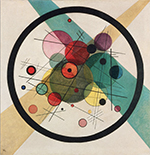
Concentric, Eccentric
"a coruscating whirl of circles that by their tangled multitude of repeated curves,
uniformity of form,
and confusion of intersecting lines suggested
a rendering
of cosmic chaos, the
symbolism
of a
mad art
attempting the inconceivable” (34).
Joseph Conrad The Secret Agent (1907)
Joseph Conrad's "The Idiots" (1896), in Tales 43-62
- how does Conrad’s manner of introducing the first cognitively disabled character shape the reader’s preconceptions about the “idiot” (43)?
- does the narrator’s neurotypical bias carry the ring of authority as he draws conclusions about the nature of individuals with a cognitive difference?
- would it be a mistake to conflate Conrad’s perspective with that of his first-person narrator? Can you separate out two different angles of approach to the story’s central topic?
- does the description of the wedding procession contain details that prognosticate the unexpected procreative outcome of this marriage?
- do Conrad’s descriptions of the setting, scattered throughout this tale, establish a neutral tone, or do they veer towards either the glorious or gloomy?
- what drives Jean-Pierre Bacadou to pursue significant change on his farm?
- why is the elder Bacadou so unsettled and surly following the twins’ birth?
- are Jean-Pierre and Susan happy about having kids for the same reason?
- why is the marquis glad that Jean-Pierre has participated in the Sunday mass?
- why has Jean-Pierre begun to attend mass?
- does this story suggest that either cognitive disability or mental illness is hereditary?
- what does Susan mean by the defensive claim “there are things no woman can bear” (59)?
- consider Conrad’s construction of religious practice; does it appear in a positive light at any point?
Joseph Conrad's The Secret Agent (1907), chps. 1-3
- what subtle techniques does Conrad deploy to deflate his secret agent?
- what about Winnie is so attractive to not only Verloc but her mother’s other lodgers?
- does Conrad describe Stevie’s intellectual disability in a way that makes it amusing?
- what do you make of the circles drawn by Stevie?
- what is the endgame of Wurmt and Vladimir, and how does the latter suggest Verloc go about creating the desired state of affairs?
- are Vladimir’s ideas plausible or nonsensical?
- do the ideas of the four members of the “Future of the Proletariat” society resemble one another more than they differ? Do any of their ideas sound more plausible than the others’?
- what does the narrator himself think of the anarchists?
- later in the novel, Winnie will look at Stevie and her husband Adolf Verloc and muse that the two look somehow similar, like father and son. Thus far, do these two characters appear to be mirror images of one another as concerns native intellect?
- does the ridiculous Adolf Verloc finally become sympathetic at the close of chapter three?

Circles in a Fire (1923)
Wassily Kandinsky
Dr. Paul Marchbanks
pmarchba@calpoly.edu
![]()
